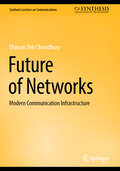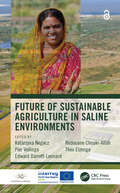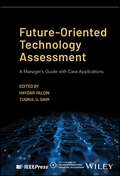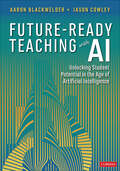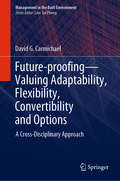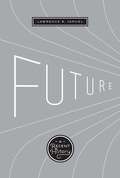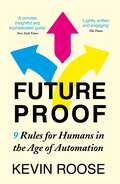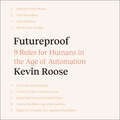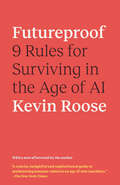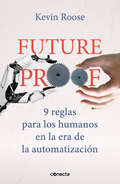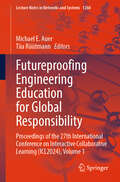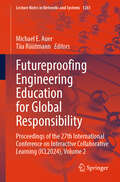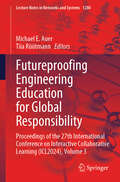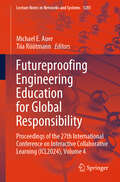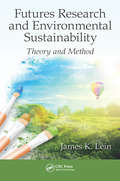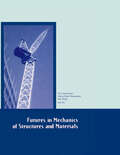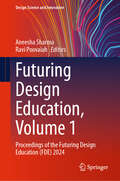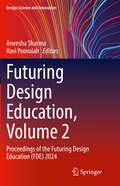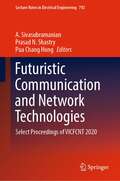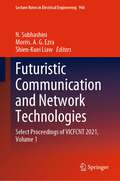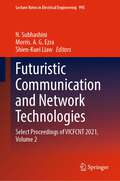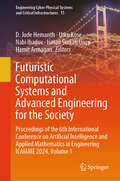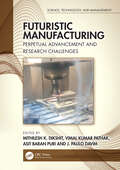- Table View
- List View
Future of Networks: Modern Communication Infrastructure (Synthesis Lectures on Communications)
by Dhiman Deb ChowdhuryThis book provides a comprehensive discussion about the trends in network transformation towards intelligent networks and what the future holds for communication infrastructure. The author unveils the interplay of technologies and technological know-how that are shaping the industry. Delving into the evolution of networking infrastructures from static to dynamic and intelligent, this book explores how these advancements are enhancing user experiences, driving digital transformation in businesses, and revolutionizing the way the world connects. Covering trends in networking technologies, advances in SOCs, cloud networking, automation, network insights (telemetry and observability), container networking, network security, and AI infrastructure, readers will gain valuable insights into the cutting-edge technologies shaping the landscape of communication infrastructure. Whether you're a seasoned industry professional or a newcomer to the field, this book offers an invaluable resource for understanding the latest advancements and future directions in networking technology.
Future of Sustainable Agriculture in Saline Environments
by Katarzyna NegaczFood production on present and future saline soils deserves the world’s attention particularly because food security is a pressing issue, millions of hectares of degraded soils are available worldwide, freshwater is becoming increasingly scarce, and the global sea-level rise threatens food production in fertile coastal lowlands. Future of Sustainable Agriculture in Saline Environments aims to showcase the global potential of saline agriculture. The book covers the essential topics, such as policy and awareness, soil management, future crops, and genetic developments, all supplemented by case studies that show how this knowledge has been applied. It offers an overview of current research themes and practical cases focused on enhancing food production on saline lands. FEATURES Describes the critical role of the revitalization of salt-degraded lands in achieving sustainability in agriculture on a global scale Discusses practical solutions toward using drylands and delta areas threatened by salinity for sustainable food production Presents strategies for adaptation to climate change and sea-level rise through food production under saline conditions Addresses the diverse aspects of crop salt tolerance and microbiological associations Highlights the complex problem of salinity and waterlogging and safer management of poor-quality water, supplemented by case studies A PDF version of this book is available for free in Open Access at www.taylorfrancis.com. It has been made available under a Creative Commons Attribution-Non Commercial-No Derivatives 4.0 license.
Future-Oriented Technology Assessment: A Manager's Guide with Case Applications (IEEE Press Series on Technology Management, Innovation, and Leadership)
by Tugrul U. Daim Haydar YalçınComprehensive resource explaining how to evaluate technologies for different purposes in any industry using four different practical approaches Future-Oriented Technology Assessment offers a comprehensive view of technology assessment structured into three different practical approaches: Technology Evaluation, Technology Roadmapping, and Technology Intelligence. The first four chapters include studies which utilize technology gap analysis, multiple criteria decision analysis, expert assessment quantification or neural networks to evaluate or forecast technology alternatives. The next five chapters apply bibliometric analysis, patent analysis, and network analysis to identify technology trends and the leaders in the field. The final four chapters use technology roadmapping, which charts a comprehensive plan for implementing technology. Additional topics covered in Future-Oriented Technology Assessment include: Smart grid technology as an alternative to fossil fuel consumptionHeat pump water heaters that reduce the cost of energy and improve energy efficiency, with particular focus on research from the US and ChinaNanotechnology in construction in Saudi Arabia to improve heat insulation, energy efficiency, and tensile strength in green building designs With comprehensive, practical insight into evaluating emerging technologies across different industries, Future-Oriented Technology Assessment is an essential read for researchers in technology and professionals in engineering and technology management, along with professionals and graduate students in related disciplines and programs of study.
Future-Ready Teaching With AI: Unlocking Student Potential in the Age of Artificial Intelligence (Corwin Teaching Essentials)
by Aaron Blackwelder Jason CowleyPrepare your students for a future where AI literacy is crucial Artificial intelligence (AI) is here and seems on the brink of transforming education. As teachers, we know that AI will not diminish the need for students to learn essential skills. It will, however, change how we teach and will require us to develop new skill sets for instruction and assessment. Teachers have a new opportunity—to embrace future-ready instruction that prepares students to engage in a world that expects them to be AI literate. In Future-Ready Teaching With AI: Unlocking Student Potential in the Age of Artificial Intelligence, authors Aaron Blackwelder and Jason Cowley explore the integration of AI in the classroom and its potential to revolutionize teaching. Much more than simply a book about using AI tools, this rich resource aims to help teachers raise rigor, increase engagement, and promote more meaningful learning opportunities in their classrooms as they embrace the future of teaching and learning. Offering evergreen principles and strategies to help educators navigate the age of AI, this book Encourages critical thinking about the ethical use of AI to foster conversations with students Highlights various practical tools that can help teachers meet diverse student learning needs as well as create AI-proof assignments Includes chapter vignettes, sample AI prompts, activities, reflective questions, and links to online resources to support teachers′ work in the classroom Examines how to leverage AI to streamline rudimentary tasks such as lesson planning, assessment, and differentiation, allowing teachers to focus on building relationships, providing feedback, and personalizing learning for their students Written by two secondary teachers, this book is an essential resource for K–12 teachers and administrators looking to move beyond the basics of using AI. By equipping educators to become leaders in this transformation, Future-Ready Teaching With AI demonstrates how to harness the power of AI to help every student thrive.
Future-Ready Teaching With AI: Unlocking Student Potential in the Age of Artificial Intelligence (Corwin Teaching Essentials)
by Aaron Blackwelder Jason CowleyPrepare your students for a future where AI literacy is crucial Artificial intelligence (AI) is here and seems on the brink of transforming education. As teachers, we know that AI will not diminish the need for students to learn essential skills. It will, however, change how we teach and will require us to develop new skill sets for instruction and assessment. Teachers have a new opportunity—to embrace future-ready instruction that prepares students to engage in a world that expects them to be AI literate. In Future-Ready Teaching With AI: Unlocking Student Potential in the Age of Artificial Intelligence, authors Aaron Blackwelder and Jason Cowley explore the integration of AI in the classroom and its potential to revolutionize teaching. Much more than simply a book about using AI tools, this rich resource aims to help teachers raise rigor, increase engagement, and promote more meaningful learning opportunities in their classrooms as they embrace the future of teaching and learning. Offering evergreen principles and strategies to help educators navigate the age of AI, this book Encourages critical thinking about the ethical use of AI to foster conversations with students Highlights various practical tools that can help teachers meet diverse student learning needs as well as create AI-proof assignments Includes chapter vignettes, sample AI prompts, activities, reflective questions, and links to online resources to support teachers′ work in the classroom Examines how to leverage AI to streamline rudimentary tasks such as lesson planning, assessment, and differentiation, allowing teachers to focus on building relationships, providing feedback, and personalizing learning for their students Written by two secondary teachers, this book is an essential resource for K–12 teachers and administrators looking to move beyond the basics of using AI. By equipping educators to become leaders in this transformation, Future-Ready Teaching With AI demonstrates how to harness the power of AI to help every student thrive.
Future-proofing—Valuing Adaptability, Flexibility, Convertibility and Options: A Cross-Disciplinary Approach (Management in the Built Environment)
by David G. CarmichaelThis book presents a unifying approach to the valuation of incorporated flexibility. Flexibility, in general terms, recognizes future uncertainty and refers to being proactive now so as to secure the future possibility of being able to adapt, convert, or generally introduce a change, if it is worthwhile to do so at the time. That is, deliberate provision is made now in order to have the ability (but not the obligation) to adapt, convert, or change in the future; this change is discretionary, and depends on future circumstances. The applications demonstrated here cover engineering, building, housing, finance, economics, contracts, general management, and project management. The examples are as follows: designing/building features in infrastructure (including buildings and houses) such that the infrastructure can be adapted in response to future changes in climate, demographics, or usage; incorporating features in contracts such that the terms and conditions can be changed in response to changing situations; purchasing rights now such that options exist to buy or sell an asset in the future; structuring a financial investment agreement so that its terms and conditions can be changed in the future; structuring project payments to provide future guarantees of revenue if needed; and designing an operation such that it can be expanded, contracted, abandoned, switched, changed, delayed, or deferred in the future. The level of required mathematics is kept at a very modest level: an undergraduate knowledge of algebra and probability is all that is required. Numerical examples, accompanied by readily understandable diagrams, illustrate the methods outlined. The formulations are kept straightforward and accessible for practitioners and academics alike.
Future: A Recent History
by Lawrence R. SamuelThe history of our attitudes toward the possibilities of tomorrow:&“A fascinating trek through American future visions from the 1920s to the present.&” —Lori C. Walters, Ph.D., University of Central Florida The future is not a fixed idea but a highly variable one that reflects the values of those who are imagining it. By studying the ways that visionaries imagined the future—particularly that of America—in the past century, much can be learned about the cultural dynamics of the times. In this social history, Lawrence R. Samuel examines the future visions of intellectuals, artists, scientists, businesspeople, and others to tell a chronological story about the history of the future in the past century. He defines six separate eras of future narratives from 1920 to the present day, and argues that the milestones reached during these years—especially related to air and space travel, atomic and nuclear weapons, the women&’s and civil rights movements, and the advent of biological and genetic engineering—sparked the possibilities of tomorrow in the public&’s imagination, and helped make the twentieth century the first century to be significantly more about the future than the past. The idea of the future grew both in volume and importance as it rode the technological wave into the new millennium, and the author tracks the process by which most people, to some degree, have now become futurists as the need to anticipate tomorrow accelerates.
Futureproof: 9 Rules for Humans in the Age of Automation
by Kevin Roose'Kevin Roose provides a clear, compelling strategy for surviving the next wave of technology with our jobs - and souls - intact... Futureproof is the survival guide you need' Charles Duhigg, The Power of HabitIn this timely, counterintuitive, and highly practical guide to the age of A.I. and automation, a New York Times technology columnist argues that the key to success is making yourself more human, not less.The machines are here. After decades of sci-fi doomsaying and marketing hype, advanced A.I. and automation technologies have leapt out of research labs and Silicon Valley engineering departments and into the center of our lives. The world's biggest corporations are racing to automate jobs, and some experts predict that A.I could put millions of people out of work. But all is not lost. With a little effort, we can become futureproof. In Futureproof: 9 Rules for Machine-Age Humans, New York Times technology columnist Kevin Roose lays out an optimistic vision of how people can thrive in the machine age by rethinking their relationship with technology, and making themselves irreplaceably human.
Futureproof: 9 Rules for Humans in the Age of Automation
by Kevin Roose'Kevin Roose provides a clear, compelling strategy for surviving the next wave of technology with our jobs - and souls - intact... Futureproof is the survival guide you need' Charles Duhigg, The Power of HabitIn this timely, counterintuitive, and highly practical guide to the age of A.I. and automation, a New York Times technology columnist argues that the key to success is making yourself more human, not less.The machines are here. After decades of sci-fi doomsaying and marketing hype, advanced A.I. and automation technologies have leapt out of research labs and Silicon Valley engineering departments and into the center of our lives. The world's biggest corporations are racing to automate jobs, and some experts predict that A.I could put millions of people out of work. But all is not lost. With a little effort, we can become futureproof. In Futureproof: 9 Rules for Machine-Age Humans, New York Times technology columnist Kevin Roose lays out an optimistic vision of how people can thrive in the machine age by rethinking their relationship with technology, and making themselves irreplaceably human.(P) 2021 Penguin Random House Audio
Futureproof: 9 Rules for Surviving in the Age of AI
by Kevin RooseA practical, deeply reported survival guide for the age of AI, written by the New York Times tech columnist who has introduced millions to the promise and pitfalls of artificial intelligence. &“Artificial intelligence can be terrifying, but Kevin Roose provides a clear, compelling strategy for surviving the next wave of technology with our jobs—and souls—intact.&”—Charles Duhigg, author of The Power of Habit It&’s time to get real about AI. After decades of hype and sci-fi fantasies, AI—artificial intelligence—is leaping out of research labs and into the center of our lives. Millions of people now use tools like ChatGPT and DALL-E 2 to write essays, create art and finish coding projects. AI programs are already beating humans in fields like law, medicine and entertainment, and they&’re getting better every day. But AI doesn&’t just threaten our jobs. It shapes our entire human experience, steering our behavior and influencing our choices about which TV shows to watch, which clothes to buy, and which politicians to vote for. And while many experts argue about whether a robot apocalypse is near, one critical question has gone unanswered: In a world where AI is ascendant, how can humans survive and thrive? In Futureproof: 9 Rules for Humans in the Age of Automation, New York Times technology columnist Kevin Roose shares the secrets of people and organizations that have successfully navigated waves of technological change, and explains what skills are necessary to stay ahead of the curve today, with lessons like • Be surprising, social, and scarce• Resist machine drift• Leave handprints• Demote your devices• Treat AI like a chimp army Roose rejects the conventional wisdom that in order to compete with AI, we have to become more like robots ourselves—hyper-efficient, data-driven workhorses. Instead, he says, we should focus on being more human, and doing the kinds of creative, inspiring, and meaningful things even the most advanced algorithms can&’t do.
Futureproof: 9 reglas para los humanos en la era de la automatizacion
by Kevin Roose¿Qué significa ser humano en un mundo construido cada vez más por y para máquinas? Las máquinas ya están aquí; la automatización está sustituyendo los trabajos de las personas, la inteligencia artificial se ha colocado en el centro de los negocios y de nuestras vidas, y los algoritmos dan forma a todo lo que nos rodea. EnFutureproof: 9 reglas para los humanos en la era de la automatización, Kevin Roose rechaza la creencia popular de que paracompetir con las máquinas tenemos que parecernos a ellas: hipereficientes, basadas en datos, caballos de batalla al servicio del código. En su lugar, sostiene que debemos dejar a las máquinas ser máquinas y enfocarnos en hacer las actividades creativas, inspiradoras y con sentido que nos distinguen como seres humanos. Para lograrlo, nos comparte nueve lecciones para reflexionar, sobrevivir al cambio tecnológico y proteger nuestro futuro: Regla 1. Sé sorprendente, sociable y excepcional. Regla 2. Resiste el embate de las máquinas. Regla 3. Haz a un lado tus dispositivos. Regla 4. Deja huella. Regla 5. No seas un punto de conexión. Regla 6. Trata la IA como si fuera un ejército de chimpancés. Regla 7. Construye redes grandes y pequeñas. Regla 8. Aprende humanidades para la era de las máquinas. Regla 9. Arma a los rebeldes. Una visión pragmática y esperanzadora sobre cómo podemos defendernos del paso arrasador de la automatización y cómo alcanzar el éxito en la era de las máquinas al convertirnos en humanos irremplazables.
Futureproof: 9 reglas para los humanos en la era de la automatizacion
by Kevin Roose«Una guía concisa, esclarecedora y sofisticada para defender los valores humanos en la nueva era de las máquinas.» The New York Times Book Review Las máquinas ya están aquí. Los algoritmos dan forma a todo lo que nos rodea: los programas que vemos, la música que escuchamos, los productos que compramos o las relaciones que creamos. Y mientras seguimos inmersos en el eterno debate de si la automatización destruirá nuestros puestos de trabajo, ignoramos una pregunta importante: ¿Qué significa ser humano en un mundo diseñado cada vez más por y para las máquinas? En Futureproof: 9 reglas para los humanos en la era de la automatización, el columnista de The New York Times Kevin Roose rechaza la creencia popular de que para competir con las máquinas tenemos que parecernos a ellas: hipereficientes esclavos de los datos. Mantiene, en cambio, que debemos enfocarnos en desarrollar las actividades creativas, inspiradoras y relevantes que nos distinguen como seres humanos. Roose revela los secretos de las personas y las organizaciones que han sobrevivido al cambio tecnológico y explica cómo podemos proteger nuestro futuro con lecciones como: Regla 1. Sé sorprendente, sociable y excepcional Regla 2. Resiste el embate de las máquinas Regla 3. Haz a un lado tus dispositivos Regla 4. Deja huella Regla 5. No seas un punto de conexión Regla 6. Trata la IA como si fuera un ejército de chimpancés Regla 7. Construye redes grandes y pequeñas Regla 8. Aprende humanidades para la era de las máquinas Regla 9. Arma a los rebeldes Una guía pragmática y esperanzadora sobre cómo defendernos del avance arrasador de las máquinas y prosperar en la era de la automatización convirtiéndonos en humanos irremplazables. Reseñas:«Una clara y convincente estrategia para superarla siguiente ola de la tecnología con nuestros trabajos (y almas) intactos. Tanto si eres optimista como pesimista sobre el futuro, Futureproof es la guía de supervivencia que necesitas.»Charles Duhigg, autor de Más agudo, más rápido y mejor y El poder de los hábitos «Kevin Roose nos enseña cómo las personas podemos hacer frente individualmente al cambio tecnológico anteponiendo siempre la humanidad.»Andrew Yang, candidato demócrata a la presidencia de EEUU y defensor de la renta básica universal
Futureproofing Engineering Education for Global Responsibility: Proceedings of the 27th International Conference on Interactive Collaborative Learning (ICL2024), Volume 1 (Lecture Notes in Networks and Systems #1260)
by Michael E. Auer Tiia RüütmannThis book contains papers in the fields of: Collaborative learning. Digital transition in education. AI and learning analytics in engineering education. Diversity in engineering education. The authors are currently witnessing a significant transformation in the development of education on all levels and especially in post-secondary and higher education. To face these challenges, higher education must find innovative and effective ways to respond in a proper way. Changes have been made in the way we teach and learn, including the massive use of new means of communication, such as videoconferencing and other technological tools. Moreover, the current explosion of artificial intelligence tools is challenging teaching practices maintained for centuries. Scientifically based statements as well as excellent best practice examples are necessary for effective teaching and learning engineering. The 27th International Conference on Interactive Collaborative Learning (ICL2024) and 53rd Conference of International Society for Engineering Pedagogy (IGIP), which took place in Tallinn, Estonia, between 24 and 27 September 2024, was the perfect place where current trends in higher education were presented and discussed. IGIP conferences have been held since 1972 on research results and best practices in teaching and learning from the point of view of engineering pedagogy science. ICL conferences have been held since 1998 being devoted to new approaches in learning with a focus on collaborative learning in Higher Education. Nowadays, the ICL conferences are a forum of the exchange of relevant trends and research results as well as the presentation of practical experiences in learning and Engineering Pedagogy. In this way, the authors try to bridge the gap between ‘pure’ scientific research and the everyday work of educators. Interested readership includes policymakers, academics, educators, researchers in pedagogy and learning theory, schoolteachers, learning industry, further and continuing education lecturers, etc.
Futureproofing Engineering Education for Global Responsibility: Proceedings of the 27th International Conference on Interactive Collaborative Learning (ICL2024), Volume 2 (Lecture Notes in Networks and Systems #1261)
by Michael E. Auer Tiia RüütmannThis book contains papers in the fields of: Collaborative learning. Digital transition in education. AI and learning analytics in engineering education. Diversity in engineering education. The authors are currently witnessing a significant transformation in the development of education on all levels and especially in post-secondary and higher education. To face these challenges, higher education must find innovative and effective ways to respond in a proper way. Changes have been made in the way we teach and learn, including the massive use of new means of communication, such as videoconferencing and other technological tools. Moreover, the current explosion of artificial intelligence tools is challenging teaching practices maintained for centuries. Scientifically based statements as well as excellent best practice examples are necessary for effective teaching and learning engineering. The 27th International Conference on Interactive Collaborative Learning (ICL2024) and 53rd Conference of International Society for Engineering Pedagogy (IGIP), which took place in Tallinn, Estonia, between 24 and 27 September 2024, was the perfect place where current trends in higher education were presented and discussed. IGIP conferences have been held since 1972 on research results and best practices in teaching and learning from the point of view of engineering pedagogy science. ICL conferences have been held since 1998 being devoted to new approaches in learning with a focus on collaborative learning in Higher Education. Nowadays, the ICL conferences are a forum of the exchange of relevant trends and research results as well as the presentation of practical experiences in learning and Engineering Pedagogy. In this way, the authors try to bridge the gap between ‘pure’ scientific research and the everyday work of educators. Interested readership includes policymakers, academics, educators, researchers in pedagogy and learning theory, schoolteachers, learning industry, further and continuing education lecturers, etc.
Futureproofing Engineering Education for Global Responsibility: Proceedings of the 27th International Conference on Interactive Collaborative Learning (ICL2024), Volume 3 (Lecture Notes in Networks and Systems #1280)
by Michael E. Auer Tiia RüütmannThis book contains papers in the fields of: Green transition in education. New generation of engineering students. Entrepreneurship in engineering education. Open education best practices. Project-based learning (PBL). Teaching best practices. We are currently witnessing a significant transformation in the development of education on all levels and especially in post-secondary and higher education. To face these challenges, higher education must find innovative and effective ways to respond in a proper way. Changes have been made in the way we teach and learn, including the massive use of new means of communication, such as videoconferencing and other technological tools. Moreover, the current explosion of artificial intelligence tools is challenging teaching practices maintained for centuries. Scientifically based statements as well as excellent best practice examples are necessary for effective teaching and learning engineering. The 27th International Conference on Interactive Collaborative Learning (ICL2024) and 53rd Conference of International Society for Engineering Pedagogy (IGIP), which took place in Tallinn, Estonia, between September 24 and 27, 2024, was the perfect place where current trends in Higher Education were presented and discussed. IGIP conferences have been held since 1972 on research results and best practices in teaching and learning from the point of view of engineering pedagogy science. ICL conferences have been held since 1998 being devoted to new approaches in learning with a focus on collaborative learning in higher education. Nowadays, the ICL conferences are a forum of the exchange of relevant trends and research results as well as the presentation of practical experiences in learning and engineering pedagogy. In this way, we try to bridge the gap between ‘pure’ scientific research and the everyday work of educators. Interested readership includes policymakers, academics, educators, researchers in pedagogy and learning theory, schoolteachers, learning industry, further and continuing education lecturers, etc.
Futureproofing Engineering Education for Global Responsibility: Proceedings of the 27th International Conference on Interactive Collaborative Learning (ICL2024), Volume 4 (Lecture Notes in Networks and Systems #1281)
by Michael E. Auer Tiia RüütmannThis book contains papers in the fields of: Virtual and augmented learning. Games in engineering education. Social aspects of digitalization. Technical teacher training. Accessible learning and technologies. Dance of data in educational science and practice. Engineering education for production and service structures of the future. Innovative approaches to STEAM education and music therapy through emerging technologies. We are currently witnessing a significant transformation in the development of education on all levels and especially in post-secondary and higher education. To face these challenges, higher education must find innovative and effective ways to respond in a proper way. Changes have been made in the way we teach and learn, including the massive use of new means of communication, such as videoconferencing and other technological tools.
Futures Research and Environmental Sustainability: Theory and Method
by James K. LeinThis book explores the challenges of presenting sustainability as a more actionable or practical concept and identifying approaches that might offer useful assistance in addressing the temporal and spatial representation of sustainability. The underlying premise of this book is that sustainability is a state realized in the future. In that future there is a geographic arrangement of society and economy that agrees with its environmental setting. This future perspective introduces a little examined subject area that can lend significant content to the sustainability challenge: Futures Research.
Futures in Mechanics of Structures and Materials
by Hao Wang Thiru Aravinthan Warna Karu KarunasenaFutures in Mechanics of Structures and Materials is a collection of peer-reviewed papers presented at the 20th Australasian Conference on the Mechanics of Structures and Materials (ACMSM20, University of Southern Queensland, Toowoomba, Queensland, Australia, 2 - 5 December 2008) by academics, researchers and practicing engineers mainly from Austral
Futuring Design Education, Volume 1: Proceedings of the Futuring Design Education (FDE) 2024 (Design Science and Innovation)
by Ravi Poovaiah Aneesha SharmaThis book presents select proceedings of the two-day conference titled Futuring Design Education (FDE 2024), and it examines the transformation of design knowledge, the evolving spaces of learning, and the ecosystems of teaching and learning. The topics covered include the pedagogical model of design education, the experiments, and technological advances that impact design education. The book also discusses the roles and challenges of learning spaces, remote learning in digital spaces, and synchronous and asynchronous learning tools. The book will also look at the social contexts in design pedagogy, cultural affiliations and alignments and will allude to any new learning frameworks for design education. The book can be a valuable reference for design educators, design researchers, and professionals interested in design education.
Futuring Design Education, Volume 2: Proceedings of the Futuring Design Education (FDE) 2024 (Design Science and Innovation)
by Ravi Poovaiah Aneesha SharmaThis book presents select proceedings of the two-day conference titled Futuring Design Education (FDE 2024), and it examines the transformation of design knowledge, the evolving spaces of learning, and the ecosystems of teaching and learning. The topics covered include the pedagogical model of design education, the experiments, and technological advances that impact design education. The book also discusses the roles and challenges of learning spaces, remote learning in digital spaces, and synchronous and asynchronous learning tools. The book will also look at the social contexts in design pedagogy, cultural affiliations and alignments and will allude to any new learning frameworks for design education. The book can be a valuable reference for design educators, design researchers, and professionals interested in design education.
Futuristic Communication and Network Technologies: Select Proceedings of VICFCNT 2020 (Lecture Notes in Electrical Engineering #792)
by A. Sivasubramanian Prasad N. Shastry Pua Chang HongThis book presents select proceedings of the International Conference on Futuristic Communication and Network Technologies (CFCNT 2020) conducted at Vellore Institute of Technology, Chennai. It covers various domains in communication engineering and networking technologies. This volume comprises of recent research in areas like optical communication, optical networks, optics and optical computing, emerging trends in photonics, MEMS and sensors, active and passive RF components and devices, antenna systems and applications, RF devices and antennas for microwave emerging technologies, wireless communication for future networks, signal and image processing, machine learning/AI for networks, internet of intelligent things, network security and blockchain technologies. This book will be useful for researchers, professionals, and engineers working in the core areas of electronics and communication.
Futuristic Communication and Network Technologies: Select Proceedings of VICFCNT 2021, Volume 1 (Lecture Notes in Electrical Engineering #966)
by Shien-Kuei Liaw N. Subhashini Morris. A. G. EzraThis book presents select proceedings of the Virtual International Conference on Futuristic Communication and Network Technologies (VICFCNT 2021). It covers various domains in communication engineering and networking technologies. This volume comprises recent research in areas like cyber-physical systems, acoustics, speech & video signal processing, and IoT. This book is a collated work of academicians, researchers, and industry personnel from the international arena. This book will be useful for researchers, professionals, and engineers working in the core areas of electronics and communication.
Futuristic Communication and Network Technologies: Select Proceedings of VICFCNT 2021, Volume 2 (Lecture Notes in Electrical Engineering #995)
by Shien-Kuei Liaw N. Subhashini Morris. A. G. EzraThis book presents select proceedings of the Virtual International Conference on Futuristic Communication and Network Technologies (VICFCNT 2021). It covers various domains in communication engineering and networking technologies. This volume comprises recent research in areas like cyber-physical systems, acoustics, speech & video signal Processing, and the Internet of Things. This book is a collated work of academicians, researchers, and industry personnel from the international arena. This book will be useful for researchers, professionals, and engineers working in the core areas of electronics and communication.
Futuristic Computational Systems and Advanced Engineering for the Society: Proceedings of the 6th International Conference on Artificial Intelligence and Applied Mathematics in Engineering ICAIAME 2024, Volume 1 (Engineering Cyber-Physical Systems and Critical Infrastructures #15)
by D. Jude Hemanth Utku Kose Nabi Ibadov Ismail Serkan Uncu Hamit ArmaganThis book provides the most recent, quality research papers accepted and presented in the 6th International Conference on Artificial Intelligence and Applied Mathematics in Engineering (ICAIAME 2024), held in 26-27-28 September 2024 at Warsaw, Poland. Objective of the book is to provide important and innovative research for developments—improvements within different engineering fields, which are highly interested in using artificial intelligence and applied mathematics. As a collection of the outputs from ICAIAME 2024, the book ensures a perspective in terms of especially futuristic solution approaches to advance the society through innovative engineering efforts. The book allows researchers and practitioners from both academia as well as industry to exchange, share their ideas and keep themselves up to date (in terms of knowledge) in the context of the latest research efforts and further opportunities arising. As the proceedings of the ICAIAME 2024, the book eventually plays a remarkable, active role in accumulating the most recent, significant works of artificial intelligence and applied mathematics to shape both the present and future of engineering disciplines.
Futuristic Manufacturing: Perpetual Advancement and Research Challenges (Science, Technology, and Management)
by J. Paulo Davim Mithilesh K. Dikshit Vimal Kumar Pathak Asit Baran PuriIncreased industrial capacity, manufacturing output, and manufacturing technology all contribute significantly to a country's GDP. Manufacturing is the foundation of industrial production, so improving its methods and infrastructure is crucial for progress. Recent years have seen the introduction of a wide range of energy- and resource-efficient, environmentally friendly, and occupationally safe manufacturing techniques, and this book focuses on these latest techniques, as well as continuous advancement, in order to meet current challenges. The book is divided into three sections: (1) subtractive manufacturing, (2) additive manufacturing, and (3) the use of artificial intelligence in manufacturing. It discusses micromaching, metal-based additive manufacturing, polymer-based additive manufacturing, hybrid additive manufacturing, and finally artificial intelligence in manufacturing. Futuristic Manufacturing: Perpetual Advancement and Research Challenges connects modern manufacturing methods and emerging trends in the industry. It adds a thorough examination of modern manufacturing techniques and modifications that may be implemented in the future, and is an excellent resource of information for undergraduate and graduate students in manufacturing.
